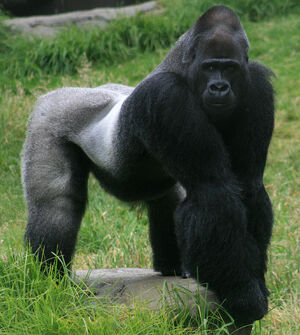The western gorilla (Gorilla gorilla) is a hominid native to Africa and one of the two species of the genus Gorilla.
Description[]
Western gorillas are generally lighter colored than eastern gorillas. Western lowland gorillas have black, dark grey or dark brown-grey hair with a brownish forehead. Males average 167 cm (5 ft 5.7 in) although reaching a height up to 176 cm (5 ft 9.3 in), with males having an average weight of 168 kilograms (370 lb) and females weighing 58 to 72 kilograms (128 to 159 lb). Captive western gorillas average 157 kg (346 lb) in males and 80 kg (176 lb) in females. Another source describes the weight of wild male western lowland gorillas as 146 kg. The Cross River gorilla differs from the western lowland gorilla in both skull and tooth dimensions.
Behavior and ecology[]
Western gorillas live in groups that vary in size from two to twenty individuals. Such groups are composed of at least one male, several females and their offspring. A dominant male silverback heads the group, with younger males usually leaving the group when they reach maturity. Females transfer to another group before breeding, which begins at eight to nine years old; they care for their young infants for the first three to four years of their lives. The interval between births, therefore, is long, which partly explains the slow population growth rates that make the western gorilla so vulnerable to poaching. Due to the long gestation time, long period of parental care, and infant mortality, a female gorilla will only give birth to an offspring that survives to maturity every six to eight years. Gorillas are long-lived and may survive for as long as 40 years in the wild. A group's home range may be as large as 30 square km, but is not actively defended. Wild western gorillas are known to use tools.
Western gorillas' diets are high in fiber, including leaves, stems, fruit, piths, flowers, bark, invertebrates, and soil. The frequency of when each of these are consumed depends on the particular gorilla group and the season. Furthermore, different groups of gorillas eat differing numbers and species of plants and invertebrates, suggesting they have a food culture. Fruit comprises most of the gorillas' diets when it is abundant, directly influencing their foraging and ranging patterns. There is a correlation between the amount of time a Western lowland gorilla travels and the season in which fruits are available. The Western lowland gorillas spend more time traveling and feeding during the seasons when fruits are abundant compared to when there is less fruits available. Fruits of the genera Tetrapleura, Chrysophyllum, Dialium, and Landolphia are favored by the gorillas. Low-quality herbs, such as leaves and woody vegetation, are only eaten when fruit is scarce. In the dry season from January to March, when fleshy fruits are few and far between, more fibrous vegetation such as the leaves and bark of the low-quality herbs Palisota and Aframomum are consumed. Of the invertebrates consumed by the gorillas, termites and ants make up the majority. Caterpillars, grubs, and larvae are also consumed in rarity.
Some ethnographic and pharmacological studies have suggested a possible medicinal value in particular foods consumed by the western gorilla. The fruit and seeds of multiple Cola species are consumed. Given the low protein content, the main reason for their consumption may be the stimulating effect of the caffeine in them. Western gorillas inhabiting Gabon have been observed consuming the fruit, stems, and roots of Tabernanthe iboga, which, due to the compound ibogaine in it, acts on the central nervous system, producing hallucinogenic effects. It also has effects comparable to caffeine. There is also evidence for medicinal value for the seed pods of Aframomum melegueta in lowland gorillas' diets, which seem to have some sort of cardiovascular health benefit for lowland gorillas, and are a known part of the natural diets for many wild populations.
A study published in 2007 announced the discovery of this species fighting back against possible threats from humans. They "found several instances of gorillas throwing sticks and clumps of grass". This is unusual, because gorillas usually flee and rarely charge when they encounter humans.
One mirror test in Gabon shows that western gorilla silverbacks react aggressively when faced with a mirror, although refusing to look fully at their reflection.
Individual western gorillas[]
- Jambo†
- Koko†
- Harambe†
- Willie B.†
- Snowflake†
- Colo†
- Timmy†
- Pattycake†
- Bokito
